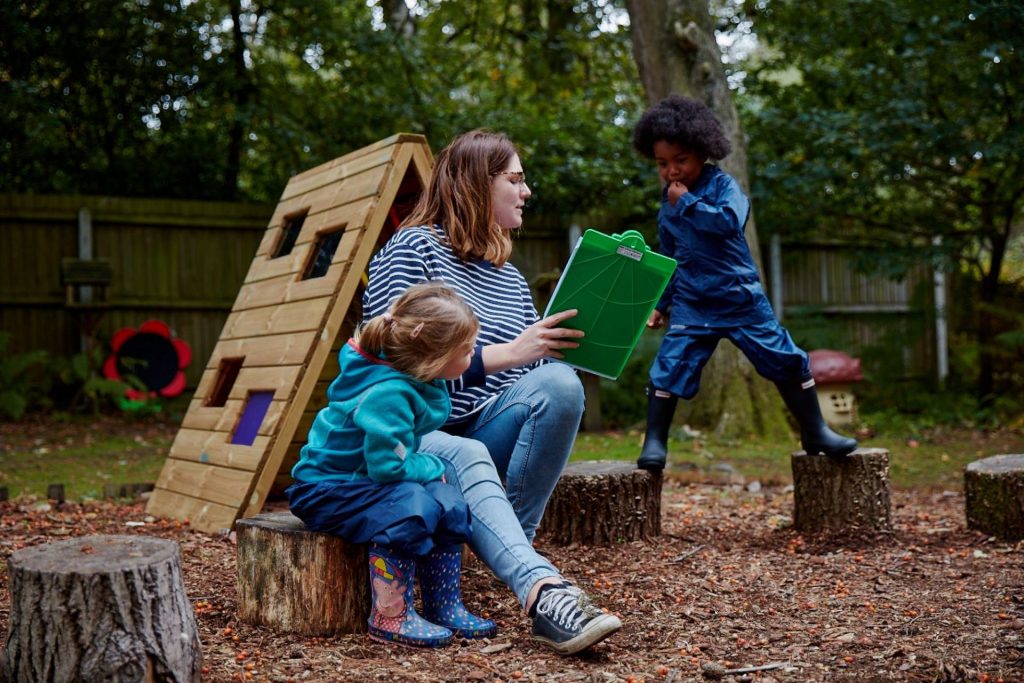The Wolds Day Nursery share their journey with us, explaining how they introduced risk taking into their learning.
The start of the journey
At The Wolds, we have been very fortunate regarding our space and have always wanted to use this to the best effect. We found that our children were given limited opportunities to take part in learning that included risk. This was due to the associated worries from adults and limited opportunities throughout lockdown to stretch the children’s physical capabilities. So, we decided to start our journey and add more elements of risk into our learning. We thoroughly risk assess our creations and equipment but acknowledge that the learning and developmental benefits often outweigh the risk.

Introducing the children to safety and risk
We have spent lots of time building upon the children’s understanding of safety and supporting them to assess risks. This has been a slow and thorough process. We have focussed on introducing different aspects of ‘risk’, one step at a time.
First, we began by adding simple obstacle courses which prompted children’s balance and coordination. As children became more familiar and confident, we added more opportunities that allowed them to practice new skills.

To extend the children’s climbing, we used stacked pallets to provide sturdy yet accessible opportunities for exploring spatial awareness and balance. Currently, we have a variety of climbing equipment that caters for all abilities. These include some structures created from reclaimed ladders and scaffold boards, some purpose-built equipment such as a donated dome climbing frame and monkey bars.
Risk assessing in play
The children love den making and creating their own spaces so we decided to give children the opportunities to risk assess during these familiar activities. As skilful practitioners, we began by observing. We occasionally interjected with carefully worded questions that supported the children’s problem solving skills and risk assessing skills.

Initially, practitioners felt they had to observe the children very closely, almost holding themselves back from interrupting, but ensuring they were safe. However, the children’s conversations soon developed. They began to offer each other advice, risk assess situations together, and collaborate more within their play. We noticed friendships blooming between the keen builders and the children soon began to discover each other’s talents. Some children flourished when problem solving whilst others were noticed for their homely decorating and role play skills. The children began to risk assess as they stacked, shifted and maneuvered different materials to make their creations.
Introducing tools
We incorporated the use of tools in our forest school environment. This supports children to understand how to use tools safely and appropriately. We often begin by using tools such as vegetable peelers on vegetables before we begin to whittle sticks. Children are introduced to child sized tools such as mallets, hammers and hacksaws in a variety of contexts to practise their handling. We often give the tool handling a purpose e.g. building a composter or creating discs to use in our sport sessions.
Involving the parents
The children find the most exciting part of our forest school teaching is our fire making sessions. During our initial set up ,the first hurdle to overcome was getting the parents on board. This took a while and consisted of honest, open dialogue with the parents. The benefits were explained and we demonstrated how the sessions would be delivered. This eased the parents concerns and they were soon eager to get their children involved.Our fire sessions are led by our trained forest school lead and risk assessed. The children begin to learn about the importance of safety and boundaries around fire making very quickly. The boundaries are repeated and stated clearly before any equipment is introduced.

The children become familiar with the tools involved in fire building and know what to do to put the fire out. These sessions require observant adults to assess each child’s readiness to partake in this activity. We have found these sessions support the children’s personal, social and emotional development brilliantly, as initially, the learning focusses on boundaries. As time goes on, the children begin to remind each other of the boundaries and start to self-regulate. They work collaboratively, and as part of a team, to create the fire and extend the sessions to involve their skills with tools too, such as peeling the vegetables to make a hearty soup for everyone to enjoy.
Skills for life
Our practitioners are very passionate about children assessing their own risks and giving children the skills and confidence to trust their own thinking. We carefully scaffold children’s learning so they can think critically, be resilient and achieve what they set out to do. Not just in our early years setting, but throughout their lives.
Thank you to Emma, Deputy Manager at The Wolds Day Nursery for sharing this blog with us.


